NVIDIA's 1.4 Billion Transistor GPU: GT200 Arrives as the GeForce GTX 280 & 260
by Anand Lal Shimpi & Derek Wilson on June 16, 2008 9:00 AM EST- Posted in
- GPUs
SLI Performance Throwdown: GTX 280 SLI vs. 9800 GX2 Quad SLI
We had two GeForce GTX 280s on hand and a plethora of SLI bridges, so we of course had to run them in SLI. Now remember that a single GTX 280 uses more power than a GeForce 9800 GX2, and thus two of them is going to use a lot of power. It was so much power in fact that our OCZ EliteXStream 1000W power supply wasn't enough. While the SLI system would boot and get into Windows, we couldn't actually complete any benchmarks. All of the power supplies on the GTX 280 SLI certified list are at least 1200W units. We didn't have any on hand so we had to rig up a second system with a separate power supply and used the second PSU to power the extra GTX 280 card. A 3-way SLI setup using GTX 280s may end up requiring a power supply that can draw more power than most household circuits can provide.
Although a single GeForce GTX 280 loses to a GeForce 9800 GX2 in most cases, scaling from two to four GPUs is never as good as scaling from one to two. Thus forcing the question: are a pair of GTX 280s in SLI faster than a 9800 GX2 Quad SLI setup?
Let's look at the performance improvements from one to two cards across our games:
| GTX 280 SLI (Improvement from 1 to 2 cards) | 9800 GX2 SLI (Improvement from 1 to 2 cards) |
|
| Crysis | 50.1% | 30.3% |
| Call of Duty 4 | 62.8% | 64.0% |
| Assassin's Creed | 38.9% | 12.7% |
| The Witcher | 54.9% | 36.2% |
| Bioshock | 68.4% | 63.7% |
| Oblivion | 72.3% | -35.7% |
Crysis, Assassin's Creed, The Witcher and Oblivion are all situations where performance either doesn't scale as well or drops when going from one to two GX2s, giving NVIDIA a reason to offer two GTX 280s over a clumsy Quad SLI setup.
Thanks to poor Quad SLI scaling, the GX2 SLI and the GTX 280 SLI perform the same, despite the GTX 280 being noticeably slower than the 9800 GX2 in single-card mode.
When it does scale well however, the GX2 SLI outperforms the GTX 280 SLI setup just as you'd expect.
Sometimes you run into serious issues with triple and quad SLI where performance is actually reduced; Oblivion at 2560 x 1600 is one of those situations and the result is the GTX 280 SLI gives you a better overall experience.
While we'd have trouble recommending a single GTX 280 over a single 9800 GX2, a pair of GTX 280s will probably give you a more hassle-free, and consistent experience than a pair of 9800 GX2s.


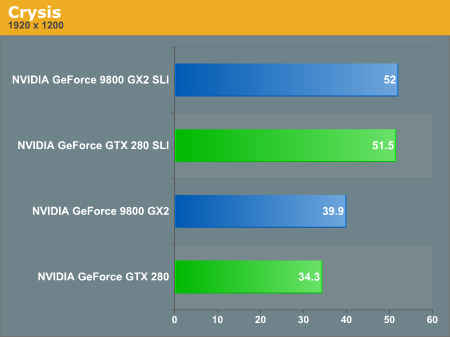
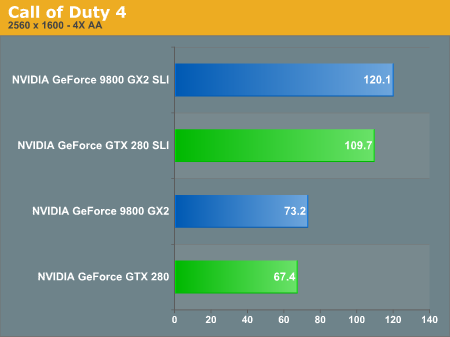

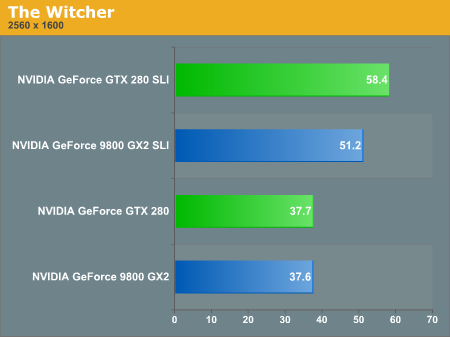
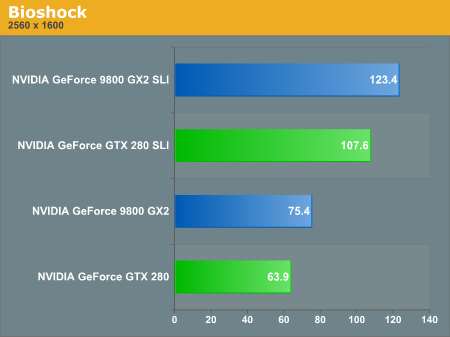
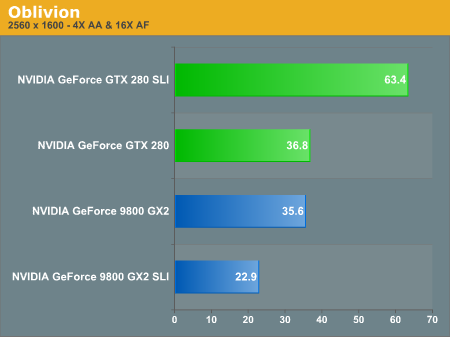








108 Comments
View All Comments
strikeback03 - Tuesday, June 17, 2008 - link
So are you blaming nvidia for games that require powerful hardware, or just for enabling developers to write those games by making powerful hardware?InquiryZ - Monday, June 16, 2008 - link
Was AC tested with or without the patch? (the patch removes a lot of performance on the ATi cards..)DerekWilson - Monday, June 16, 2008 - link
the patch only affects performance with aa enabled.since the game only allows aa at up to 1680x1050, we tested without aa.
we also tested with the patch installed.
PrinceGaz - Monday, June 16, 2008 - link
nVidia say they're not saying exactly what GT200 can and cannot do to prevent AMD bribing game developers to use DX10.1 features GT200 does not support, but you mention that"It's useful to point out that, in spite of the fact that NVIDIA doesn't support DX10.1 and DX10 offers no caps bits, NVIDIA does enable developers to query their driver on support for a feature. This is how they can support multisample readback and any other DX10.1 feature that they chose to expose in this manner."
Now whilst it is driver dependent and additional features could be enabled (or disabled) in later drivers, it seems to me that all AMD or anyone else would have to do is go through the whole list of DX10.1 features and query the driver about each one. Voila- an accurate list of what is and isn't supported, at least with that driver.
DerekWilson - Monday, June 16, 2008 - link
the problem is that they don't expose all the features they are capable of supporting. they won't mind if AMD gets some devs on board with something that they don't currently support but that they can enable support for if they need to.what they don't want is for AMD to find out what they are incapable of supporting in any reasonable way. they don't want AMD to know what they won't be able to expose via the driver to developers.
knowing what they already expose to devs is one thing, but knowing what the hardware can actually do is not something nvidia is interested in shareing.
emboss - Monday, June 16, 2008 - link
Well, yes and no. The G80 is capable of more than what is implemented in the driver, and also some of the implemented driver features are actually not natively implemented in the hardware. I assume the GT200 is the same. They only implement the bits that are actually being used, and emulate the operations that are not natively supported. If a game comes along that needs a particular feature, and the game is high-profile enough for NV to care, NV will implement it in the driver (either in hardware if it is capable of it, or emulated if it's not).What they don't want to say is what the hardware is actually capable of. Of course, ATI can still get a reasonably good idea by looking at the pattern of performance anomalies and deducing which operations are emulated, so it's still just stupid paranoia that hurts developers.
B3an - Monday, June 16, 2008 - link
@ Derek - I'd really appreciate this if you could reply...Games are tested at 2560x1600 in these benchmarks with the 9800GX2, and some games are even playable.
Now when i do this with my GX2 at this res, a lot of the time even the menu screen is a slide show (often under 10FPS). Epecially if any AA is enabled. Some games that do this are Crysis, GRID, UT3, Mass Effect, ET:QW... with older games it does not happen, only newer stuff with higher res textures.
This never happened on my 8800GTX to the same extent. So i put it down to the GX2 not having enough memory bandwidth and enough usable VRAM for such high resolution.
So could you explain how the GX2 is getting 64FPS @ 2560x1600 with 4x AA with ET:Quake Wars? Aswell as other games at that res + AA.
DerekWilson - Monday, June 16, 2008 - link
i really haven't noticed the same issue with menu screens ... except in black and white 2 ... that one sucked and i remember complaining about it.to be fair i haven't tested this with mass effect, grid, or ut3.
as for menu screens, they tend to be less memory intensive than the game itself. i'm really not sure why it happens when it does, but it does suck.
i'll ask around and see if i can get an explaination of this problem and if i can i'll write about why and when it will happen.
thanks,
Derek
larson0699 - Monday, June 16, 2008 - link
"Massiveness" and "aggressiveness"?I know the article is aimed to hit as hard as the product it's introducing us to, but put a little English into your English.
"Mass" and "aggression".
FWIW, the GTX's numbers are unreal. I can appreciate the power-saving capabilities during lesser load, but I agree, GT200 should've been 55nm. (6pin+8pin? There's a motherboard under that SLI setup??)
jobrien2001 - Monday, June 16, 2008 - link
Seems Nvidia finally dropped the ball.-Power consumption and the price tag are really bad.
-Performance isnt as expected.
-Huge Die
Im gonna wait for a die shrink or buy an ATI. The 4870 with ddr5 seems promising from the early benchmarks... and for $350? who in their right mind wouldnt buy one.